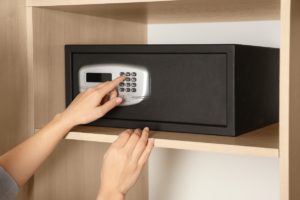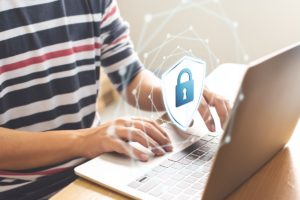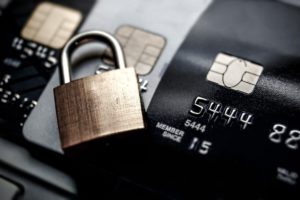Securing valuables is always a good idea. Three generations ago, a federally insured financial institution for savings and a safety deposit box for paperwork were acceptable repositories. Today, your financial information is as valuable as the actual cash, and more security measures are required to ensure financial data security.
 In the digital era, your financial data – account numbers, account credentials, and identifying data such as passcodes and social security numbers – are targeted by criminals. There were approximately 2.5 billion accounts breached by cybercriminals in 2018. With identifying data and account numbers, hackers can access all of your accounts that they can find, including checking, savings, 401K, investment portfolios, lines of credit, and more.
In the digital era, your financial data – account numbers, account credentials, and identifying data such as passcodes and social security numbers – are targeted by criminals. There were approximately 2.5 billion accounts breached by cybercriminals in 2018. With identifying data and account numbers, hackers can access all of your accounts that they can find, including checking, savings, 401K, investment portfolios, lines of credit, and more.
Here, we’re going to talk about how to ensure your assets and financial information are protected. Let’s start with first things first.
Be Careful with Personal Information
A lot of employers and financial organizations use social security numbers as a key piece of identifying information. How many times have you called your utility company, credit union, or credit card and the service representative asks you for the last four digits of your social security number? Those numbers are the key that opens the vault that gives you access to your money.
Imagine what a criminal who is good at his or her trade could accomplish with just the last four digits of your social. Or your mother’s maiden name.
Protecting financial data begins by being judicious in sharing. When someone asks for your sensitive information, ask what it will be used for and find out if there’s another way to identify you.
Pro Tip: Many doctors’ offices ask for your social security number – Don’t give it to them! You don’t have to and it keeps you – and your financial information – safer.
Also, never use your birthplace, birthdate, mother’s maiden name, and other info as passwords to your financial or computer accounts, and avoid sharing this type of information on social media or through email.
Choose Repositories Carefully
 Your safety starts with where you choose to store your important information, both in the real world and the digital world. Here are suggestions of places to protect your financial data:
Your safety starts with where you choose to store your important information, both in the real world and the digital world. Here are suggestions of places to protect your financial data:
Storage offline
• Secure lockbox at your primary financial institution
• Secure files with your Attorney, CPA, and Financial Advisor
• Wall safe (copies only)
• Fire-proof, heavy-duty locked cabinet, or box (copies only)
Storage online
Encrypt the financial documents that you keep in a file folder on your personal computer, in a secure cloud service, or downloaded onto a flash drive. There are software systems to encrypt the data, popular choices include AxCrypt and Certain Safe.
Financial Data Security Offline
Lock up original paperwork and minimize the number of copies you have lying around to maximize financial security.
Tax returns, insurance cards, Medicare and social security cards along with paper statements from your financial institutions should be locked away in your safety deposit box or in your safe or a locked cabinet.
To ensure you’ll have access to your financial information if your original documents are lost or destroyed, create redundancy by making a copy of the paperwork and secure it in a separate location.
Financial Security Online
 Proper virus protection is a must, especially if you conduct your banking and bill paying online or receive eStatements from financial institutions in your inbox. Do you communicate with your accountant or financial advisor through email or instant messaging? Make sure those conversations remain private by using anti-virus protection; two popular options are Norton 360 Protection or McAfee Total Protection.
Proper virus protection is a must, especially if you conduct your banking and bill paying online or receive eStatements from financial institutions in your inbox. Do you communicate with your accountant or financial advisor through email or instant messaging? Make sure those conversations remain private by using anti-virus protection; two popular options are Norton 360 Protection or McAfee Total Protection.
Don’t reuse your passwords. Each of your applications should have a unique password. To keep them safe and in one place, look into a free LastPass account to store passwords.
When it’s time to get rid of your computer, wipe all of the data from the hard drive. You can easily find wipe utility programs by searching for “wipe utility programs”.
Phishing and Malware
Be on the lookout for phishing scams and malware by scrutinizing emails. Phishing is the criminal practice of sending emails that appear to be from legitimate organizations, such as government agencies, banks, or other businesses, and asks that you either send sensitive information or provide a credit card. If you receive such an email, it’s worth the five minutes it will take to call the organization to see if the email is legitimate.
Malware can hide in videos or links that are sent from a hacked account. Even if the email is from a friend, think twice before clicking on an unsolicited link.
Create a Contingency Plan for your Financial Data Security
Despite all of the financial data security plans, you may still be compromised. How would you know? What’s the first thing you’d do? It’s not pleasant to think about but having a plan in place can help minimize the damage. Here’s how to minimize the damage:
1. Before fraud happens, add a Fraud Alert on one of the three major credit bureaus, Experian, TransUnion, and Equifax. If your information is stolen, activate the fraud alert and the Bureau will inform all of your lenders that your information may have been compromised.
2. Monitor your credit reports to look for credit inquiries that you didn’t initiate.
3. Review your financial accounts regularly for fraudulent charges.
4. Activate a Credit Freeze at all of the Credit Bureaus. The freeze tells any lender who is checking on a fraudulent application that you don’t want any new loans or credit cards.
Identity Theft Protection
 For those who want peace of mind and the backing of experts to help keep your financial data secure, there are identity theft protection services. These services will offer multi-layer protection for your personal information, from credit monitoring (including dark web monitoring), to recovery and many have insurance of up to $1million included in their service.
For those who want peace of mind and the backing of experts to help keep your financial data secure, there are identity theft protection services. These services will offer multi-layer protection for your personal information, from credit monitoring (including dark web monitoring), to recovery and many have insurance of up to $1million included in their service.
While LifeLock is one of the most well-known, others like IDShield, IdentityForce and PrivacyGuard are also popular. Forbes recently published an article about the best identity theft protection services for 2021 and includes tips on how to pick the best one.
Be Mindful of Changes
Many of the precautions above weren’t necessary 30 years ago; 10 years from now, some of the precautions may be obsolete or upgraded to meet different requirements. The convenience of online communication and access has created a higher risk that is ever-evolving and keeping financial data security in mind is of primary importance.
If it’s time to choose a financial advisor, look for one that is mindful of keeping your financial plans and data secure; and one with a fiduciary responsibility to act in your best interest. Stableford Capital embraces a consultative approach to keep you informed so you’ll feel that your assets and financial data are secure. Take advantage of our complimentary 15-minute consultation to learn more.
